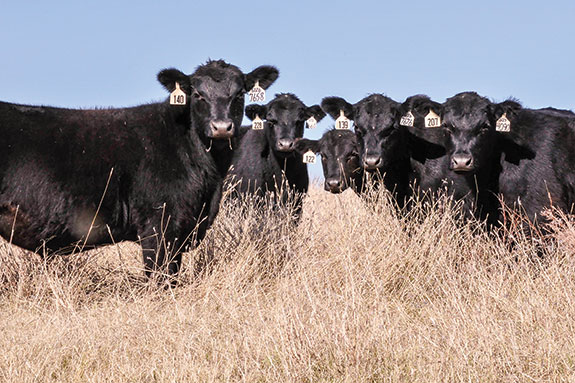These pests can affect profitability and the health of a herd.
Depending on the area of the country, these effects can be drastic.
In the South, the hot, dry climate is the perfect breeding ground for many pests, and cattle producers must be especially stringent about their pest management plans.
One operation that has implemented a successful pest management plan is the LeReve Ranch in Lindsay, Oklahoma, owned by Marshall and Tevarhee Brackin.
“With both of us having a rodeo background, it was our dream when we married to own a cattle ranch and live the lifestyle together,” says Marshall Brackin of the ranch that began in 2005.
“Our business is producing naturally raised, premium Angus-influenced beef, with strict management practices for a product that is healthy and enjoyed by all.”
The family owns its cattle from conception through processing. “Our program that we have designed is the result of countless hours of research and study.
To gain the knowledge, we have attended classes and seminars all around the country,” he says.
He adds, “We do not harvest any animal that is not a result of our breeding and raised under our control from birth to harvest.”
The reason for this is because they wanted to be able to produce a superior product that they knew everything about.
“LeReve Ranch is a working cattle ranch with the goal of producing premium beef with you, the consumer in mind,” Brackin says.
The ranch runs between 25 and 100 cattle, depending on the demand they see for their beef. Right now that demand is high.
“We sell directly to consumers through farmers markets. A lot of people find out about us through that. These people want to buy local, and they want to buy natural. We provide that,” he states.
The family runs mostly Angus cattle, with some influence of Simmental and Limousin in their cowherd. Their bulls are Angus.

To help manage their pests, the ranch first starts with a dewormer.
“We deworm everything, and that takes care of most of the problems,” says Brackin.
He continues, “We also use some fly control during certain times of the year.
We have used a pour-on to help control flies and ticks, and have sprayed as well.”
The family regularly checks its cattle for problems and believes that being proactive helps to stop problems before they start.
“We do things at certain times to stay ahead of the problem. It’s easier to stay ahead of it in our part of the country, and we closely manage our cattle every day,” Brackin says.
He believes management is the key, and coupled with good genetics, allows a producer to keep the herd healthy. “We try to prevent issues before they become problems,” he explains.
One of the biggest problems cattlemen deal with is horn flies. “As spring arrives and temperatures start to creep up, it is time to make horn fly control decisions,” says Dr. Justin Talley, extension livestock entomologist for Oklahoma State University.
“Horn flies are a common fly species associated with livestock,” he says. “They are a small black fly and feed on cattle in an inverted position with their head facing down.
Both male and female horn flies take blood from the host and feed 20 to 30 times a day. Horn flies continually stay on the animal and only leave the animal for short periods to lay eggs.
Typical feeding areas on cattle include the back, side, belly and legs of cattle. Horn fly populations begin building up in the spring as early as April and last until the first frost.
The life cycle of horn flies lends itself to building large populations on cattle if control is not implemented.”
Horn flies can go through an entire life cycle in as few as 14 days, leading to a large number of flies over the six-month to seven-month window they can survive.
“The adult female fly must lay her eggs in fresh cow manure. The eggs hatch within 48 hours into first instar larvae, which feed in the manure pat and progressively grow into second and third instar larvae.
Larvae of the horn fly develop only in fresh cattle manure. Third instar larvae crawl from the manure pat to a drier area and pupate.
Inside the pupal case, the adult fly forms and the adult will emerge from the pupal case and seek a suitable host, typically cattle,” says Talley.
The impact pests can have on cattle varies by region. Horn flies are especially a problem in Southern states, however, and can greatly reduce weight gains in cattle.
“Horn flies can have significant impacts on growing cattle. The main impact is the reduction in weight gain, especially in weaning weights for spring-born calves.
Some studies have attributed a 1½ pound of extra gain per week when horn flies are controlled. The reduction in weight occurs mainly because of stress on the cow, which can then result in reduced milk flow or production,” Talley explains.
He adds, “This stress is caused by horn flies because they are a blood-feeding insect. The loss of blood and stress from biting activity results in direct economic impacts (reduced weights).
Considering today’s market value for cattle, the impact is even larger.”
Another part of the Brackins’ pest management strategy is not based on any product given to the animal, but on the condition of the cow.
“The biggest thing is we feed them, even in a dry period. We try not to let their body condition score drop below a 6. We keep them between 6 and 8 all the time. We feel this helps them to combat pests,” he says.
During both periods of the year when they’re calving, there is not a lot of grass available. So they feed alfalfa starting 30 days before the cows are due. The cows are then fed alfalfa through lactation, until they can go back to grass.
“We feel that improves their milk production and helps them maintain condition,” Brackin says.
In addition to their pest management plan, the family has a strict health program. “All cattle receive vaccinations on a strict health protocol designed by Dr. LD and Mark Barker of Professional Animal Health Center located in New Castle, Oklahoma.
We practice humane animal-handling techniques to create a stress-free environment, which produces a high-quality product,” says Brackin.
“We believe preventive maintenance helps us provide healthy, high-quality beef.” ![]()
PHOTOS
TOP: Marshall and Tevarhee Brackin started their ranch in 2005 by pushing tight pest controls on the naturally raised, premium Angus beef herd.
BOTTOM: The LeReve Ranch has implemented a pest management plan with thorough deworming, fly control and pour-ons for ticks for its largely Angus-influenced cattle. Photos courtesy of LeReve Ranch.








